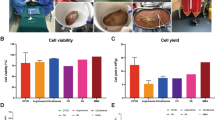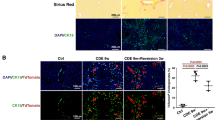Abstract
Background
Acute liver failure (ALF) is characterized by impaired regeneration of hepatocytes, partially resulting from the defective signaling between elevated levels of hepatocyte growth factor (HGF) and the downregulation of its receptor, c-met.
Aims
In this study, we assess the therapeutic efficacy of in vivo c-met gene transfer in ALF.
Methods
We established a d-galactosamine/lipopolysaccharide (d-GalN/LPS)-induced ALF model in rats. The levels of HGF and c-met in d-GalN/LPS rats were compared with vehicle-injected rats and those undergoing liver regeneration following partial hepatectomy (PH). To deliver c-met in vivo, pcDNA-c-met was constructed and transfected into the rat liver via hydrodynamic injection. Control rats were transfected with the pcDNA3.1 plasmid. The expressions of c-met in different tissues were examined by immunohistochemistry. Hepatocyte proliferation and apoptosis were determined by PCNA staining and TUNEL assay, respectively. The survival of rats in the control and c-met-expressing rats was compared by Kaplan–Meier analysis.
Results
Compared with control rats, d-GalN/LPS or PH -treated rats had significantly higher levels of HGF (P < 0.01). d-GalN/LPS also led to significantly lower c-met expression in the liver (P < 0.01) than PH. The in vivo c-met gene transfer led to its specific expression on hepatocytes, which was accompanied by the enhancement of hepatocyte proliferation, a reduction in apoptosis, as well as significant improvement in overall survival (P < 0.01).
Conclusions
This study provides the initial evidence that c-met may serve as a novel target for gene therapy, and may be of clinical benefit in the treatment of patients with ALF.






Similar content being viewed by others
References
McKenzie TJ, Lillegard JB, Nyberg SL. Artificial and bioartificial liver support. Semin Liver Dis. 2008;28:210–217.
Riordan SM, Williams R. Perspectives on liver failure: past and future. Semin Liver Dis. 2008;28:137–141.
Polson J, Lee WM. AASLD position paper: the management of acute liver failure. Hepatology. 2005;41:1179–1197.
Han DW. Intestinal endotoxemia as a pathogenetic mechanism in liver failure. World J Gastroenterol. 2002;8:961–965.
Liu M, Chan CW, McGilvray I, Ning Q, Levy GA. Fulminant viral hepatitis: molecular and cellular basis, and clinical implications. Expert Rev Mol Med. 2001;2001:1–19.
Naoumov NV, Eddleston AL. Host immune response and variations in the virus genome: pathogenesis of liver damage caused by hepatitis B virus. Gut. 1994;35:1013–1017.
Wu Z, Han M, Chen T, Yan W, Ning Q. Acute liver failure: mechanisms of immune-mediated liver injury. Liver Int. 2010;30:782–794.
Zhu CL, Yan WM, Zhu F, et al. Fibrinogen-like protein 2 fibroleukin expression and its correlation with disease progression in murine hepatitis virus type 3-induced fulminant hepatitis and in patients with severe viral hepatitis B. World J Gastroenterol. 2005;11:6936–6940.
Rutherford A, Chung RT. Acute liver failure: mechanisms of hepatocyte injury and regeneration. Semin Liver Dis. 2008;28:167–174.
Matsumoto K, Nakamura T. Hepatocyte growth factor: molecular structure, roles in liver regeneration, and other biological functions. Crit Rev Oncog. 1992;3:27–54.
Nakamura T. Hepatocyte growth factor as mitogen, motogen and morphogen, and its roles in organ regeneration. Princess Takamatsu Symp. 1994;24:195–213.
Schmidt C, Bladt F, Goedecke S, et al. Scatter factor/hepatocyte growth factor is essential for liver development. Nature. 1995;373:699–702.
Huh CG, Factor VM, Sanchez A, Uchida K, Conner EA, Thorgeirsson SS. Hepatocyte growth factor/c-met signaling pathway is required for efficient liver regeneration and repair. Proc Natl Acad Sci USA. 2004;101:4477–4482.
Ganschow R, Knoke A, Drews D, Burdelski M. Tissue expression of HGF, c-met, TNF[alpha], IL-6 and IL-1Ra in acute liver failure and liver cirrhosis of childhood: correlation with serum cytokines. J Pediatr Gastroenterol Nutr. 1997;24:482.
Mizuguchi T, Kamohara Y, Hui T, et al. Regulation of c-met expression in rats with acute hepatic failure. J Surg Res. 2001;99:385–396.
Ravikumar V, Shivashangari KS, Devaki T. Hepatoprotective activity of Tridax procumbens against d-galactosamine/lipopolysaccharide-induced hepatitis in rats. J Ethnopharmacol. 2005;101:55–60.
Higgins GM, Anderson RM. Experimental pathology of the liver.I. Restoration of the liver of the white rat following partial surgical removal. Arch Pathol. 1931;12:186–202.
Maruyama H, Higuchi N, Kameda S, Miyazaki J, Gejyo F. Rat liver-targeted naked plasmid DNA transfer by tail vein injection. Mol Biotechnol. 2004;26:165–172.
Maruyama H, Higuchi N, Nishikawa Y, et al. High-level expression of naked DNA delivered to rat liver via tail vein injection. J Gene Med. 2002;4:333–341.
Nowak M, Gaines GC, Rosenberg J, et al. LPS-induced liver injury in D-galactosamine-sensitized mice requires secreted TNF-alpha and the TNF-p55 receptor. Am J Physiol Regul Integr Comp Physiol. 2000;278:R1202–R1209.
Ishiki Y, Ohnishi H, Muto Y, Matsumoto K, Nakamura T. Direct evidence that hepatocyte growth factor is a hepatotrophic factor for liver regeneration and has a potent antihepatitis effect in vivo. Hepatology. 1992;16:1227–1235.
Fujiwara K, Nagoshi S, Ohno A, et al. Stimulation of liver growth by exogenous human hepatocyte growth factor in normal and partially hepatectomized rats. Hepatology. 1993;18:1443–1449.
Ishii T, Sato M, Sudo K, et al. Hepatocyte growth factor stimulates liver regeneration and elevates blood protein level in normal and partially hepatectomized rats. J Biochem. 1995;117:1105–1112.
Roos F, Terrell TG, Godowski PJ, Chamow SM, Schwall RH. Reduction of alpha-naphthylisothiocyanate-induced hepatotoxicity by recombinant human hepatocyte growth factor. Endocrinology. 1992;131:2540–2544.
Kaido T, Yoshikawa A, Seto S, et al. Portal branch ligation with a continuous hepatocyte growth factor supply makes extensive hepatectomy possible in cirrhotic rats. Hepatology. 1998;28:756–760.
Yasuda H, Imai E, Shiota A, Fujise N, Morinaga T, Higashio K. Antifibrogenic effect of a deletion variant of hepatocyte growth factor on liver fibrosis in rats. Hepatology. 1996;24:636–642.
Kosai K, Matsumoto K, Funakoshi H, Nakamura T. Hepatocyte growth factor prevents endotoxin-induced lethal hepatic failure in mice. Hepatology. 1999;30:151–159.
Kosai K, Matsumoto K, Nagata S, Tsujimoto Y, Nakamura T. Abrogation of Fas-induced fulminant hepatic failure in mice by hepatocyte growth factor. Biochem Biophys Res Commun. 1998;244:683–690.
Rutherford AE, Hynan LS, Borges CB, et al. Serum apoptosis markers in acute liver failure: a pilot study. Clin Gastroenterol Hepatol. 2007;5:1477–1483.
D’Errico A, Fiorentino M, Ponzetto A, et al. Liver hepatocyte growth factor does not always correlate with hepatocellular proliferation in human liver lesions: its specific receptor c-met does. Hepatology. 1996;24:60–64.
Verma IM, Weitzman MD. Gene therapy: twenty-first century medicine. Annu Rev Biochem. 2005;74:711–738.
Nguyen TH, Ferry N. Liver gene therapy: advances and hurdles. Gene Ther. 2004;11:S76–S84.
Zhu CL, Li YW, Gao RT. Gene therapy for acute liver failure. Curr Gene Ther. 2010;10:156–166.
Liu F, Song Y, Liu D. Hydrodynamics-based transfection in animals by systemic administration of plasmid DNA. Gene Ther. 1999;6:1258–1266.
Suda T, Liu D. Hydrodynamic gene delivery: its principles and applications. Mol Ther. 2007;15:2063–2069.
Ueno M, Uchiyama K, Nakamori M, et al. Adenoviral vector expressing hepatocyte growth factor promotes liver regeneration by preoperative injection: the advantages of performing selective injection to the remnant lobe. Surgery. 2007;141:511–519.
Acknowledgments
We thank Medjaden Bioscience Limited for assisting in the preparation of this manuscript. This study was supported by the grants from the National Natural Science Foundation of China (NSFC, No. 30800973) and the Science and Technological Fund of Anhui Province for Outstanding Youth (No.10040606Y14).
Conflict of interest
The authors declare that they have no competing of interests.
Author information
Authors and Affiliations
Corresponding author
Rights and permissions
About this article
Cite this article
Zhu, C., Li, Y., Li, W. et al. Gene Transfer of c-met Confers Protection Against d-Galactosamine/Lipopolysaccharide-Induced Acute Liver Failure. Dig Dis Sci 57, 925–934 (2012). https://doi.org/10.1007/s10620-012-2052-4
Received:
Accepted:
Published:
Issue Date:
DOI: https://doi.org/10.1007/s10620-012-2052-4




